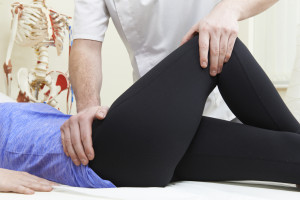Let’s dive back in to my hip replacement surgery conversation with Physical Therapist Amy Dougherty, who discusses what sports to avoid after hip surgery and what it feels like when a person suffer an artificial hip failure:
Safe and Unsafe Activities and Sports
Clay: What are some sports that you would discourage [after hip replacement surgery]? I know there is a huge range of results and people who are dealing with certain physical issues. But are there any sports you’ve seen as a physical therapist that you say “Do not do this after hip replacement surgery?”
Amy: Oh absolutely and just to clarify my youngest total hip replacement patient was eleven. This child had a very aggressive cancerous tumor that invaded her hip, and so she had what is called a Ewing sarcoma. And so, they ended up having to take the hip give her a new hip, and her big goal was she wanted to be able to drive a car. I mean that is really important. So, she was eleven when the process started and she did not drive a car. So, and I have treated, I actually had a ninety five year old who had, so the spectrum of age is even greater than thirty five to eighty two.
Clay: Sure.
Amy: But there are absolutely some things that are just absolute no’s. And most of them are things that make sense, like contact sports. So things like football, rugby, soccer. There was a great little study that came out, I think it was in 2011. Anyway, it basically looked at all of these different sports and it reviewed all of the literature and it was looking at what are the things that we know are absolute no-no’s.
Amy: And we know this because the literature shows us that these people had high rates of failure in their hips. Oh and by the way, this recommendation basically it was a systematic review and when they made these recommendations, they qualify them into three categories. So, the first category was not recommended after a total hip and so the contact sports hockey, football, soccer, rugby, any long distance running. And that just make sense.
 Amy: A lot of people take a toll on their hips by doing a lot of running, and that does not mean that running causes hip arthritic changes that create a total hip that necessitated total hip replacements. Do not misunderstand that, but there is a wear and tear process that goes on with people that are running hundreds of miles a month. So, singles tennis, it gets down to just the numbers of steps that go through that new part; racquetball, squash, snowboarding, and that is because of the risk of dislocation for snowboarding.
Amy: A lot of people take a toll on their hips by doing a lot of running, and that does not mean that running causes hip arthritic changes that create a total hip that necessitated total hip replacements. Do not misunderstand that, but there is a wear and tear process that goes on with people that are running hundreds of miles a month. So, singles tennis, it gets down to just the numbers of steps that go through that new part; racquetball, squash, snowboarding, and that is because of the risk of dislocation for snowboarding.
Amy: High impact aerobics, fast pitch baseball and softball, because of sliding and contact. The kicking that is involved in many of the martial arts is not recommended. Water skiing and handball. So those are the things that under the category of not recommended. And I will tell people flat-out “Listen, you had a bad hip, you have gone through this process to get a good hip. Be nice to it, protect it.” I understand that you are putting yourself at great risk of early failure or other complications, like dislocation and things like that that necessitate revision. So that is in the not recommended category, and then they created this other category that they call “recommended with experience.” And this actually, again, makes sense. Cross-country skiing and downhill skiing, that is not the time to start learning to ski after you have had a new joint. Now, if you have been a lifelong skier and you have the experience, by all means do it. Make a choices. Mogul fields are probably not a great idea.
Clay: Right.
Amy: If you can cross country ski downhill ski safely. Doubles tennis again, not the time to take up tennis if you have never played in your whole life and you finally have a new hip. Now is not the time to take that up. But if you have been an avid tennis player, so I would absolutely and I have a lot of patients that have gone back and my brother included in that category who has gone back onto the tennis court with a joint replacement.
Amy: Ice skating not hockey. But ice skating is okay if you have experience doing that, things like rollerblading same thing kind of inline skating and Pilates. So those are things that we recommend that are qualified as recommended with experience. I will also add now, this study came out, this recommendation, systematic review was published in 2011. Surfing goes into that category. So if you are a surfer, absolutely if you have experience on a board, you are absolutely prepared to get back on that board after a hip replacement. Not the time to start introducing that into your sport life.
Clay: See it makes sense that if you have got experience you can keep yourself from potential injury.
Amy: Precisely, and then the list of things that are highly recommended because again, you know when you are in the rehab world what you realize that people go through the surgeries for they do it purposefully and it is usually to return to some type of function or activity, that they are arthritic or their painful joint would not let them take part in, so golfing, swimming, doubles tennis, stair-climbing, so like the elliptical walking, speed walking hiking, stationary biking, bowling, these are all things that are highly recommended. We want you to go back to these things because they are going to be healthy for you. They are going to sustain the strength in the mobility that you have recovered at that new joint. But they are also going to be safe for it. They are not going to put your new joint at risk.
Clay: I see. Well that gets to the point that staying active is absolutely essential. That you do not want to pick up downhill skiing necessarily, but you absolutely after hip surgery want to be active in something. And so, it is good to get going.
Amy: I am a physical therapist. I think we all should move. We should move, that is what our bodies are designed to do. They are not designed to sit and be sedentary. They are designed to move us through space.
What It Feels Like When Artificial Hips Fail
Clay: Well, that is right. So, I have known you for quite a while and I know you have had patients that have had hip replacement surgeries fail. Can you tell me what symptoms you notice when a patient might come in and say “I had surgery a year and a half ago or two and a half years ago and something feels different. Something sounds different”? Talk about artificial hip failure.
 Amy: Sure. Absolutely, well probably, so there are different reasons that hips can fail. But the number one thing that people complain of is pain that is out of context to what they should be experiencing at that point during the rehab process or during the recovery process. So obviously, you have had a joint replacement. We expect it to be swollen. We expect it to hurt. We expect it to be sluggish. It is not going to move well.
Amy: Sure. Absolutely, well probably, so there are different reasons that hips can fail. But the number one thing that people complain of is pain that is out of context to what they should be experiencing at that point during the rehab process or during the recovery process. So obviously, you have had a joint replacement. We expect it to be swollen. We expect it to hurt. We expect it to be sluggish. It is not going to move well.
Amy: So, there is an expectation of some pain following the surgery but there is a point where that pain should be resolving. And it should be integrating and it usually lives as the tissue is healing. So the bony tissue is healing, where the new hip implant, the new appliance, has been mated with the bony surfaces, so that healing takes place and then the soft tissue around that joint is healing and you are becoming more mobile. So, that pain should frankly just gradually decrease until it is gone.
Amy: When someone’s hip has failed, that does not happen. The other thing that is really interesting, or I think that is telling, is that typically these patients have pain even when they are not moving, and a significant amount of pain. Now again, initially immediately after the surgery, it is normal to have night pain that makes it tough to be comfortable. But after a couple of weeks after a hip replacement, you should be able to sleep for periods of time. Many times people have so much pain that they cannot sleep. Like, it keeps them awake.
Amy: Nocturnal pain is always something that worries me because at the end of the day, we are kind of hardwired to get rest but pain prohibits that. To me, that is, I am always going to look very carefully at this patient because that should be something that initially pain management should be taken care of, so medications, icing, making sure that your activity levels are appropriate for that stage of your recovery.
Amy: If all of those things are in line, and this person is still telling me, “I slept an hour.” I do not like that. Immediately that is a red flag to me that I need to take a really close look at what is going on with this patient. So, pain is out of context to what the pain level should be at that point. Pain that is occurring without moving. So, it is not mechanically driven pain.
Amy: Any type of mechanical clicking, grinding, and these are things that people will sometimes report, you know, it clicks, it grinds, it snaps. Some people have reported they can actually feel it move. So those are things that tell me that something organically is not healthy in that hip, in that newly replaced hip.
Clay: Let me follow up on that. Is it your medical view that a successful hip replacement surgery should end with no pain at all after the rehab is over, and after the recovery is over that there should be little to no pain?
Amy: Absolutely, and when that does not happen, if let us say, and I have seen this before, I have had people show up a year after hip replacement and they say, “You know my hip still bothers me.” And upon assessment, there might be a really good reason. You are profoundly weak, you did not build the strength around this joint to give it stability. So your pain is actually not in the actual hip itself, it is in the pelvis because of the forces that are going through hip joint that and the musculature of the strength is not adequate to control those forces.
Amy: So, sometimes there is a reason that someone has got pain a year later. But in the absence of something like that going on, no, you should not have pain. That is the whole reason that you have this new hip put in. So if you are continuing to have pain, I tell my joint replacement patients that it takes a year to recover from these big surgeries. But that is a pretty reasonable expectation from any orthopedic surgery, be it a rotator cuff repair, an ACL reconstruction, certainly a knee or a hip replacement, or a shoulder replacement. It is not uncommon to have some discomforts and stiffness and irritability up to a year, but after that, no, it should not happen. It should not be painful. So there is a very big difference between, “like I am still aware of it” versus “this thing I can not put weight through it. It hurts so much. I can not walk. I can not sleep. I can not ascend or descend stairs. I can not lift my leg to put it into a car.” These are things that I have seen in failed hips.
Clay: Yes.
Amy: Or even just give way where you weight bear on the leg, on that failed hip, and they will fall. That is a result of a failure.
Part 3 next week.
 North Carolina Product Liability Lawyer Blog
North Carolina Product Liability Lawyer Blog


